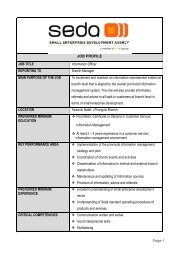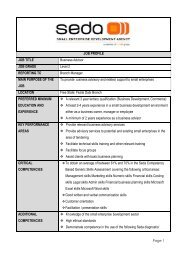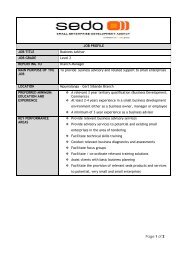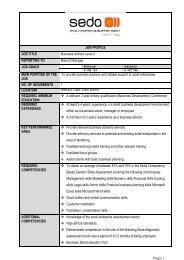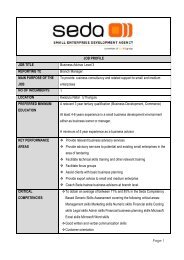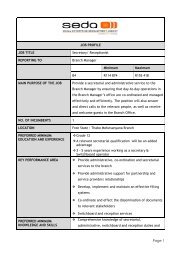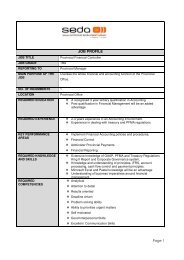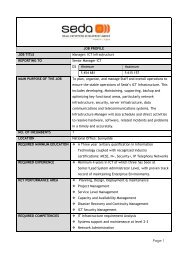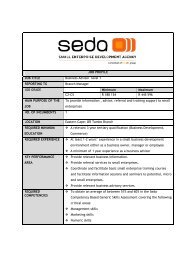Assessment of Cooperatives in the Poultry Industry - 2013.pdf - Seda
Assessment of Cooperatives in the Poultry Industry - 2013.pdf - Seda
Assessment of Cooperatives in the Poultry Industry - 2013.pdf - Seda
You also want an ePaper? Increase the reach of your titles
YUMPU automatically turns print PDFs into web optimized ePapers that Google loves.
Research Report: Address<strong>in</strong>g <strong>the</strong> Needs, Opportunities and Challenges <strong>of</strong> <strong>Cooperatives</strong><br />
and Collectively Owned Enterprises <strong>in</strong> <strong>the</strong> <strong>Poultry</strong> and Related Industries<br />
provision <strong>of</strong> assistance <strong>in</strong> <strong>the</strong>se skills may be part <strong>of</strong> <strong>the</strong> reason why few respondents noted <strong>the</strong>se as<br />
challenges.<br />
As mentioned above, <strong>the</strong> greatest challenge highlighted by cooperatives dur<strong>in</strong>g <strong>the</strong> start-up phase<br />
was <strong>the</strong> lack <strong>of</strong> equipment, with 57% <strong>of</strong> all respondents mention<strong>in</strong>g this as a concern. The Figure<br />
below illustrates <strong>the</strong> specific types <strong>of</strong> equipment that cooperatives stated <strong>the</strong>y still require. The<br />
category that received <strong>the</strong> most responses was feed/dr<strong>in</strong>k equipment for broilers, represent<strong>in</strong>g 27%<br />
<strong>of</strong> all responses and be<strong>in</strong>g listed as a challenge by 50% <strong>of</strong> cooperatives. Many cooperatives surveyed<br />
mentioned a need for more broiler houses or improved broiler house facilities, <strong>in</strong>clud<strong>in</strong>g heat<strong>in</strong>g,<br />
which came across prom<strong>in</strong>ently on its own. Lack <strong>of</strong> temperature control may lead to high mortality<br />
rates and difficulty <strong>in</strong> consistent grow<strong>in</strong>g due, to fluctuat<strong>in</strong>g conditions <strong>in</strong> <strong>the</strong> houses.<br />
A number <strong>of</strong> cooperatives <strong>in</strong>dicated that <strong>the</strong>y would prefer to diversify <strong>the</strong>ir bus<strong>in</strong>esses through <strong>the</strong><br />
build<strong>in</strong>g <strong>of</strong> abattoir facilities. Although equipment is required for this, <strong>the</strong>re are also specific health<br />
and environmental regulations and this is not as simple as atta<strong>in</strong><strong>in</strong>g <strong>the</strong> abattoir equipment. Three<br />
respondents mentioned <strong>the</strong> need for transport vehicles; one <strong>of</strong> <strong>the</strong>se was aligned with <strong>the</strong> desire to<br />
run and abattoir and thus cool<strong>in</strong>g vans were mentioned as a specific equipment need.<br />
Figure 4-6: Additional Equipment Needs (% <strong>of</strong> total responses)<br />
Source: Urban-Econ Survey, 2013<br />
In <strong>the</strong> “o<strong>the</strong>r” category <strong>in</strong> Figure 4-6 cooperatives mentioned <strong>the</strong> need for larger premises (although<br />
this is not equipment), irrigation equipment and fenc<strong>in</strong>g to improve security. Many <strong>of</strong> <strong>the</strong><br />
equipment needs mentioned by cooperatives are essential for successful production. Additional<br />
broiler houses are a needed to <strong>in</strong>crease broiler production; however, items such as heat<strong>in</strong>g<br />
equipment are basic requirements for successful operation.<br />
In start<strong>in</strong>g a bus<strong>in</strong>ess <strong>the</strong>re are a number <strong>of</strong> documents which are best practice to have <strong>in</strong> place to<br />
ensure successful establishment and management <strong>of</strong> an enterprise. These documents set out<br />
objectives and strategy with<strong>in</strong> <strong>the</strong> bus<strong>in</strong>ess, as well as outl<strong>in</strong><strong>in</strong>g tools to measure progress regard<strong>in</strong>g<br />
pr<strong>of</strong>its, <strong>in</strong>frastructure, and people. In order to evaluate <strong>the</strong> read<strong>in</strong>ess <strong>of</strong> cooperatives to form and<br />
manage <strong>the</strong>ir bus<strong>in</strong>esses, cooperatives were asked which bus<strong>in</strong>ess documents <strong>the</strong>y had <strong>in</strong> place at<br />
43 | P a g e U r b a n - E c o n : D e v e l o p m e n t E c o n o m i s t s



